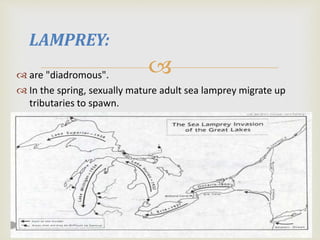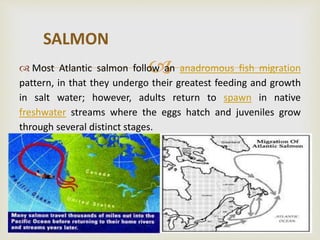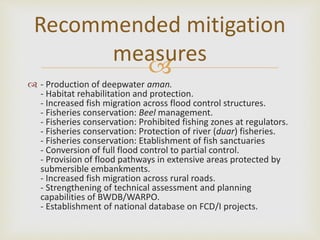Mamun
- 1. MIGRATORY FISH IN THE WORLD & IN THE BANGLADESH & THEIR POSSIBLE MIGRATORY ROUTE
- 2. INTRODUCTION Migration, in ethology, the regular, usually seasonal, movement of all or part of an animal population to and from a given area. Familiar migrants include in East Africa and in the Arctic tundra; bats; whales and birds; seals; and fishes, such as salmon. Migration can be contrasted with emigration. The migration cycle is often annual and thus closely linked with the cyclic pattern of the seasons. The distance traversed may be a few miles or several thousands of miles.
- 3. CLASSIFICATION: Three types: Anadromous fishes are ones which migrate from the sea into fresh water to spawn (e.g. salmon),; or, ones which stay entirely in fresh water and migrate upstream to spawn. Catadromous fishes are ones which migrate from fresh water into the sea to spawn (e.g. salmon),; or, ones which stay entirely in fresh water and migrate downstream to spawn. Diadromous refer to all fishes which migrate between the sea and fresh water. These included: amphidromous (fishes which migrate from fresh water to the seas, or vice versa, but not for the purpose of breeding), potadromous (fishes whose migrations occur wholly within fresh water), and oceanodromous (fishes which live and migrate wholly in the sea).
- 4. STATE: There are about 8 000 species of fish which live in freshwater and About 12 000 which live in the sea; and There are about 120 species which move regularly between the two (Cohen, 1970).
- 5. LIST OF FRESH WATER MIGRATORY SPECIES IN BANGLADESH & IN THE WORLD: Fish Base name Species Distribution Migratory status Knifetooth sawfish Anoxypristis cuspidate Australia,Bangladesh,China,India,Indonesia,Malaysia, Myanmar, Oman, Pakistan, Papua New Guinea, Philippines, Singapore, Somalia, Sri Lanka, Thailand, Anadromous Largetooth sawfish Pristis microdon Australia, Bangladesh, Cambodia, India, Indonesia,Malaysia,Mozambique,Myanmar, Papua New Guinea, Philippines, South Africa, Sri Lanka, Thailand Anadromous Smalltooth sawfish Pristis pectinata Angola, Australia, Bangladesh, Belize, Benin, Brazil, Cameroon, Cape Verde, Colombia, Cuba, Dem. Rep. of the Congo, Congo, Cote d'Ivoire, Ecuador, (France Guyana, Réunion), Equatorial Guinea, French Guiana, Gabon, Gambia, Ghana, Guinea, Guinea Bissau, India, Indonesia, Israel, (Spain – Canary Islands), Sri Lanka, South Africa, Suriname, Syrian Arab Rep, Thailand, Trinidad & Tobago, United Rep. of Tanzania, Togo, United Kingdom (Bermuda, Gibraltar), USA, Venezuela, Western Sahara Anadromous Large-tooth sawfish Pristis perotteti USA (Texas (historically), Louisiana, and occasionally south Florida), Mexico, Belize, Guatemala, Honduras, Nicaragua, Costa Rica, Colombia, Venezuela, Caribbean Sea, Mediterranean Sea. Present reported range: Senegal, Gambia, Sierra Leone, Liberia, Ivory Coast, Congo, Democratic Republic of Congo and Angola. Anadromous
- 6. LIST OF ATLANTIC HIGHLY MIGRATORY PELAGIC FISHERIES Species/stocks Major Ocean area Migratory status Albacore (T. alalunga) Northern Pacific Ocean Southern Pacifc Ocean Mediterranean Sea Northern Atlantic Ocean South Atlantic Ocean Indian Ocean Oceanodroumous Eastern Pacific Ocean Western and Central Pacific Ocean Atlantic Ocean Indian Ocean Oceanodroumous Bigeye tuna (T. obesus) Pacific bluefin tuna (T. orientalis) Pacific Ocean Atlantic bluefin tuna (T. thynnus) East Atlantic and Mediterranean Sea West Atlantic Ocean Oceanodroumous
- 7. LIST OF MIGRATORY SHARK SPECIES: Species/stock Bluntnose sixgill shark (Hexanchus griseus) Basking shark (Cetorhinus maximus) Thresher shark (Alopias pelagicus) Thresher shark (Alopias superciliosus) Thresher shark (Alopias vulpinus) Thresher shark (Alopias spp.) Whale shark (Rhincodon typus) Requiem shark (Carcharhinus falciformis) Whitetip shark (Carcharhinus longimanus) Blue shark (Prionace glauca) Winghead shark (Eusphyra blochii) Scalloped bonnethead (Sphyrna corona) Whitefin hammerhead (Sphyrna couardi) Scalloped hammerhead (Sphyrna lewini) Scoophead (Sphyrna media) Great hammerhead (Sphyrna mokarran) Bonnethead (Sphyrna tiburo) Smalleye hammerhead (Sphyrna tudes)
- 8. COMMON NAME AND SCIENTIFIC NAME OF POTAMODROMOUS FISH Serial no Common name scientific name 7 eastern mudminnow Umbra pygmaea) 8 emerald shiner Notropis atherinoides) 9 Fallfish Semotilus corporalis) 10 golden shiner Notemigonus crysoleucas) 11 goldfish Carassius auratus) 12 northern pike Esox lucius) 13 largemouth bass Micropterus salmoides) 14 mud sunfish Acantharchus pomotis) 15 green sunfish Lepomis cyanelluss) 16 eastern mudminnow Umbra pygmaea) 17 emerald shiner Notropis atherinoides)
- 9. MIGRATORY ROUTE: YELLOWFIN TUNA : migrate all together is in spawning season. They will move closer to the equator for the warmer water. Each night Yellowfin Tuna swim 9 miles out to sea to feed and then returns to shore by the next day. This is repeated every night.
- 10. LAMPREY: are "diadromous". In the spring, sexually mature adult sea lamprey migrate up tributaries to spawn.
- 11. SALMON Most Atlantic salmon follow an anadromous fish migration pattern, in that they undergo their greatest feeding and growth in salt water; however, adults return to spawn in native freshwater streams where the eggs hatch and juveniles grow through several distinct stages. Atlantic salmon do not require salt water. Numerous examples of fully freshwater (i.e., "landlocked") populations of the species exist throughout the Northern Hemisphere.In North America, the landlocked strains are frequently known as ouananiche.
- 12. TROUT The brown trout is a non-native, introduced anadromous species, of which some sea-run strains are found in a few locations on Long Island in the Bight study area. The anadromous form of brook trout, a closely related species, is not found in the study area, but is found in some of the adjacent New England waters.
- 13. MIGRATORY ROUTE OF ILISH Each year a large number of fish are caught in the Padma-Meghna-Jamuna delta, which flows into the Bay of Bengal. It is a sea fish but it lay eggs in large rivers migrates up to 1,200 km inland through rivers in the Indian sub-continent for spawning. Distances of 50–100 km are usually normal in the Bangladesh rivers. Ilish is also found in the deltaic region of southern Pakistan, in the province of Sindh. Here it is commonly referred to as the Palla fish.
- 15. POSSIBLE SPAWNING GROUND OF HILSA IN BANGLADESH 1. Dhalerchar of Charfasion in Bhola ( area at about 80 square km) 2. Monpura
- 16. Migratory route of eel : The American eel is a catadromous species that lives its adult life within inland waters along the Atlantic and Gulf coasts of North America, the St. Lawrence Seaway, and the Great Lakes; and spawns in the open ocean waters of the Sargasso Sea in the northwest Atlantic.
- 17. FISHING GROUND: There are four fishing grounds in Bangladesh. These are: Elephant Point, Kohinur Point , South of South Patch in Cox's Bazar and Sowatch of no Ground near the Sundarbans
- 18. IMPACT ON FISHING GROUND: - Loss of flooded habitat during the monsoon, resulting in a loss of fish production. - Blockage of the movements of fish (adults, juveniles and hatchlings) between external rivers and floodplains. - Reduced diversity of fish due to the prevention of migratory species entering the floodplains. - Increased fishing pressure on smaller areas of water during the monsoon, resulting in damage to the long-term sustainability of the fisheries. - Reduced dry season habitat resulting in higher fishing pressure and increased catchability of overwintering fish broodstock. The increasing use of water from beels to irrigate surrounding rice fields is of particular concern. - Reduced groundwater recharge, resulting in a lower water table in the dry season which, in turn, could lead to a reduction in the area of perennial beels..
- 19. Recommended mitigation measures - Production of deepwater aman. - Habitat rehabilitation and protection. - Increased fish migration across flood control structures. - Fisheries conservation: Beel management. - Fisheries conservation: Prohibited fishing zones at regulators. - Fisheries conservation: Protection of river (duar) fisheries. - Fisheries conservation: Etablishment of fish sanctuaries - Conversion of full flood control to partial control. - Provision of flood pathways in extensive areas protected by submersible embankments. - Increased fish migration across rural roads. - Strengthening of technical assessment and planning capabilities of BWDB/WARPO. - Establishment of national database on FCD/I projects.
- 20. CONCLUSION: Finally, not only do they choose the numerical assumptions of their quantitative models, they also choose whether to use quantitative models at all.
- 21. THANKS TO ALL




















